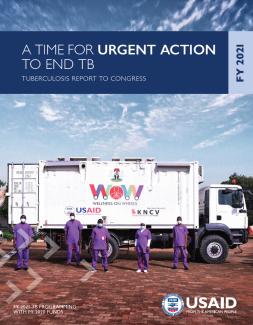The U.S. Agency for International Development (USAID) leads the U.S. Government’s global TB efforts by working with agencies and partners around the world on the shared goals of reaching every person with the disease, curing those in need of treatment, and preventing the spread of new infections and the progression to active TB disease. In cooperation with Ministries of Health, USAID provides bilateral assistance in 23 countries with high burdens of TB. Leveraging the U.S. Government’s contribution to the Global Fund to Fight AIDS, Tuberculosis and Malaria (Global Fund), USAID provides targeted technical assistance to an additional 32 countries.
During the pandemic, under-resourced TB personnel across the globe were repurposed and deployed in response to COVID-19, because of applicable skills and experience in active case detection, contact tracing, and airborne infection prevention and control. The social, economic, and biomedical consequences of COVID-19 affected the same groups at risk for TB—the most vulnerable and poorest populations in the world, who are also more likely to suffer from malnutrition and live in crowded spaces. Furthermore, those with COVID-19 and TB are about three times more likely to die than those with only TB.
The U.S. Agency for International Development (USAID) leads the U.S. Government’s global TB efforts by working with agencies and partners around the world on the shared goals of reaching every person with the disease, curing those in need of treatment, and preventing the spread of new infections and the progression to active TB disease. In cooperation with Ministries of Health, USAID provides bilateral assistance in 23 countries with high burdens of TB. Leveraging the U.S. Government’s contribution to the Global Fund to Fight AIDS, Tuberculosis and Malaria (Global Fund), USAID provides targeted technical assistance to an additional 32 countries.
In 2020, as a result of COVID-19, there was an increase in undetected and untreated TB cases, and for the first time in over a decade, TB deaths increased. In USAID’s 23 priority countries for TB programming, 1.14 million people died from TB, a seven percent increase from 2019.
Of the estimated 6.7 million people who fell ill with TB in these 23 countries, only 57 percent of estimated cases were reported to National TB Programs (NTPs) and started on treatment. This represents a more than 20 percent decline compared to 2019. In 2020, in USAID’s 23 priority countries, an estimated 866,000 people developed TB that is resistant to isoniazid (INH), out of whom 258,000 people developed deadlier, drug-resistant forms of TB (DR-TB)—TB variants that are resistant to at least INH and rifampicin. DR-TB, which includes multidrug-resistant TB (MDR-TB) and extensively drug-resistant TB (XDR-TB), remains a global public health challenge in that it is more deadly, and more difficult and expensive, to diagnose and treat. DR-TB causes one-third of all deaths due to antimicrobial resistance (AMR).
Of those with DR-TB variants, it is estimated that most acquired the resistant mycobacteria from another infected individual via airborne transmission, as opposed to developing DR-TB because of inadequate treatment, further underscoring the critical need for accelerated action in fighting the TB epidemic to safeguard global health.

